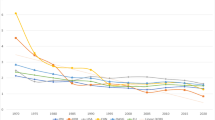Abstract
Hong Kong has moved from elite to mass post-secondary education in a very short space of time and at little cost to the Government. Most of this spectacular expansion in participation has come through enrolments in 2 year associate degrees in recently founded community colleges, which have self-financing status. The achievement has been clouded by complaints from associate degree graduates that the articulation envisaged by the government is not working; so they are unable to obtain places for undergraduate degrees in UGC-funded universities. The value of an associate degree as a suitable terminal award for employment in a knowledge-based economy is yet to be clearly established. There must be doubts as to whether students will continue to enrol in associate degrees if they provide stepping stones to neither employment nor places in undergraduate degrees in UGC-funded universities. In an attempt to deal with the lack of articulation, some community colleges, in conjunction with overseas universities, have started to offer top-up degrees to enable associate degree graduates to convert the award to a degree. However, the resulting qualifications are seen as inferior to undergraduate degrees from the UGC-funded universities.
Similar content being viewed by others
References
Education Commission. (1999). Learning for life. Hong Kong Special Administrative Region: Education Commission.
Education Commission. (2000). Review of the education system: Reform proposals. Hong Kong Special Administrative Region: Education Commission.
Education and Manpower Bureau. (2001). Learning for life: Learning through life. Hong Kong: Education and Manpower Bureau.
Education and Manpower Bureau. (2003). Education statistics. Hong Kong: Education and Manpower Bureau.
Hayhoe, R. (1995). An Asian multiversity? Comparative reflections on the transition to mass higher education in East Asia. Comparative Education Review, 39(3), 299–321. doi:10.1086/447325.
Heron, L. (2006). More degree places to be available in shake-up. South China Morning Post, p. C2.
James, R. (2000). Non-traditional students in Australian higher education: Persistent inequities and the new ideology of ‘student choice’. Tertiary Education and Management, 6(2), 105–118. doi:10.1023/A:1009617204025.
James, R., Baldwin, G., & McInnes, C. (1999). Which university? The factors influencing the choices of prospective undergraduates. Canberra: Australian Government Printing Service.
Kaiser, F., & de Weert, E. (1994). Access policies and mass higher education. In L. Goedegebuure & F. Van Vught (Eds.), Comparative policy studies in higher education. Utrecht: Center of Higher Education Policy Studies.
Kember, D. (1995). Open learning courses for adults: A model of student progress. Englewood Cliffs, NJ: Educational Technology Publications.
Kember, D. (2007). Reconsidering open and distance learning in the developing world: Meeting students’ learning needs. Abingdon, Oxfordshire: Routledge.
Kember, D., & Watkins, D. (in press). Approaches to learning and teaching by the Chinese. In M. H. Bond (Ed.), The second Oxford handbook of Chinese psychology. Oxford: Oxford University Press.
Kember, D., Hong, C., & Ho, A. (2008). Characterising the motivational orientation of students in higher education: A naturalistic study in three Hong Kong universities. The British Journal of Educational Psychology, 78, 313–329. doi:10.1348/000709907X220581.
Leatherwood, C. (2006). Accessing higher education: Policy, practice and equity in widening participation in England. In I. McNay (Ed.), Beyond mass higher education. Maidenhead: Society for Research into Higher Education and Open University Press.
Lee, W. O. (1996). The cultural context for Chinese learners: Conceptions of learning in the Confucian tradition. In D. Watkins & J. B. Biggs (Eds.), The Chinese learner: Cultural, psychological and contextual influences. Hong Kong: Melbourne and Hong Kong: Australian Council for Educational Research and the Comparative Education Research Centre, University of Hong Kong.
Longworth, N., & Davies, W. K. (1996). Lifelong learning. London: Kogan Page.
Mok, K. H. (2003). Globalisation and higher education restructuring in Hong Kong, Taiwan and mainland China. Higher Education Research & Development, 22(2), 117–129. doi:10.1080/07294360304111.
Mok, K. H. (2009). Globalisation and higher education restructuring in Hong Kong, Taiwan and mainland China. In M. Tight, K. H. Mok, J. Huisman, & C. Morphew (Eds.), Routledge international handbook of higher education. Abingdon, Oxfordshire: Routledge.
Nowotny, H. (1995). Mass higher education and social mobility: A tenuous link. In D. D. Dill & B. Spoon (Eds.), Emerging patterns of social demand and university reform: Through a glass darkly. Oxford: Pergamon.
Pearson, R. (2006). The demise of the graduate labour market. In I. McNay (Ed.), Beyond mass higher education. Maidenhead: Society for Research into Higher Education and Open University Press.
Scott, P. (1995). The meanings of mass higher education. Buckingham: Society for Research into Higher Education and Open University Press.
Trow, M. (1973). Problems in the transition from elite to mass higher education. Berkeley: Carnegie Commission on Higher Education.
Trow, M. (2006). Reflections on the transition from elite to mass to universal access: Forms and phases of higher education in modern society since WWII. In J. J. F. Forest & P. G. Altbach (Eds.), (pp. 243–280). Dordrecht: Springer.
University Grants Committee of Hong Kong (2003). Facts and figures 2002. Hong Kong: University Grants Committee Secretariat. Accessed April 21, 2004 from http://www.ugc.edu.hk/english/documents/figures/.
Wang, R. J. (2003). From elitism to mass higher education in Taiwan: The problems faced. Higher Education, 46, 261–287. doi:10.1023/A:1025320312531.
Young, E. C. M. (2005). Chairman’s report 2003–2004. Hong Kong: The Federation for Continuing Education in Tertiary Institutions.
Acknowledgment
This work was partially supported by CERG and GRF grants from the University Grants Committee of Hong Kong.
Author information
Authors and Affiliations
Corresponding author
Rights and permissions
About this article
Cite this article
Kember, D. Opening up the road to nowhere: problems with the path to mass higher education in Hong Kong. High Educ 59, 167–179 (2010). https://doi.org/10.1007/s10734-009-9241-x
Received:
Accepted:
Published:
Issue Date:
DOI: https://doi.org/10.1007/s10734-009-9241-x




